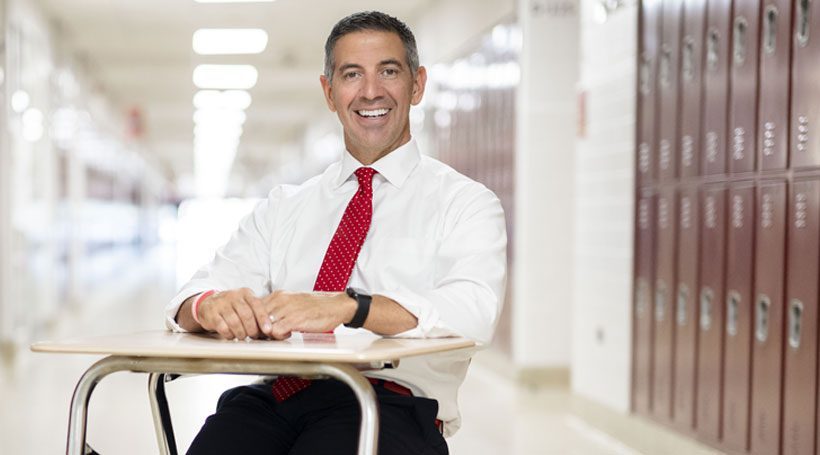PHOTO BY DAVID MICHAEL HOWARTH
Tony Cattani doesn’t measure success in rankings or statistics. The Lenape High School principal asks something harder: “Would you want your own kid sitting in your class?” He believes every teacher should be able to answer yes.
“We have great teachers, and we need to help everybody get a little better, because our kids deserve great teachers,” he says. “That’s really the platform I’ve built this on, personalizing professional development to make teachers our best teachers.”
This summer, that approach took him to Seattle, where he stood onstage at a national gala to accept the title of National High School Principal of the Year from the National Association of Secondary School Principals. With more than 1,500 principals in the room, his first instinct wasn’t to launch into a speech. It was to FaceTime his wife and four daughters, who were watching the livestream back in South Jersey.
“Besides being married and my kids being born, it was one of the highlights of my life,” says Cattani, who has spent more than 25 years in education, 19 of them as Lenape’s principal. “It meant the world to represent our school and people who saw something in me that I didn’t always see in myself.”
Q: What’s it like to be a principal for 19 years?
Nineteen years as a principal is a long time. There was a point in my career where I wasn’t loving the position. This job can be really tough and isolating on so many different levels. My wife says it all the time: You’re only as happy as your unhappiest child. And when you have 1,900 kids, 225 staff and 45,000 community members, there’s always going to be that one pit in your stomach.
But over the past 7 to 10 years, I’ve done a much better job of not allowing the work to isolate me – networking, learning from other people’s best practices, sharing my own. I’ve changed my leadership style by being vulnerable, and I think my staff and community have felt that.
I got to that point by talking to some veteran school leaders, where I realized I had to stop being so task-oriented. I was dialing in on those one or two issues every second of the day, and it wasn’t healthy. I had to go out and see the joy – to be more intentional about finding it and being in the moment.
Once I started doing that, things changed. I was interacting with kids more, staying in conversations a little longer, asking more questions and letting myself be vulnerable. People don’t want someone who’s perfect. They want someone authentic, someone willing to stand beside them and figure it out.
Q: Safety and mental health are big concerns for families. How are you addressing that?
Right now, one of the biggest anxieties parents have is about kids being safe in school. You see it all over the news – lockdowns, shootings. It’s real. At our freshman orientation, I told families the number one thing we would talk about wasn’t academics or activities, but safety.
Every one of our students needs a trusted adult. That could be a teacher, a coach, an administrator, a secretary, a custodian. We want them to feel comfortable coming forward, because you’re not going to be able to learn unless you feel safe and connected in a classroom.
That connection is what really matters. We try to build real conversations with kids and with parents, so they know there’s always someone they can go to.
We have an outstanding Wellness Center at Lenape. It’s not just a room. It’s the people in it who help kids triage through difficult situations. Maybe they come down for 20 minutes the first time, then 15, then 10, so they can build coping skills and the ability to stay in class. It’s helped students come back who were struggling with school anxiety because they know there’s a safe space in the building if something triggers them.
Q: What’s your advice for parents?
Talk with your kids more. And not just, how was your day? Ask: What was the most difficult part of your day? What was the best part? Did you thank anybody today? Stay in the conversation a little longer, be a little more curious.
And model it. We can’t tell kids to put their phones down at dinner if we’re sitting there scrolling too. We throw a lot on kids around social media, but many adults – myself included sometimes – are not the best models.
And too often, we rescue kids right away. We don’t let them struggle or advocate for themselves. I tell parents: let your kids order their own chicken tenders.
If a student misses an assignment, the first step is for them to talk to the teacher. Let them email about it before you step in. If that doesn’t work, go to the counselor. If it still isn’t resolved, then maybe the parent steps in. But 0-to-60 straight to the principal? That’s not helping them.
Q: What do you see as your most important responsibility?
For staff, my number one goal is to hire great teachers and make good teachers great. To that end, we’ve done over 4,000 peer observations in the last 7 years.
I’ve tried to model that myself – visiting principals across the county, the state, now nationally. That led to my Proud Principals Podcast, where principals share their best practices. It gives leaders a chance to celebrate the joy in what they do and spread ideas that can make schools better.
For kids, it’s making them feel like they belong. If a student walks in here and feels safe and connected, then the academics, the confidence, the success – it all follows.
We use the three Es: By graduation you should be enrolled in college or trade school, enlisted in the military or employed in a career you’re prepared for. And the way you get there is through experiences – trying things, exploring, finding out what you’re good at. But I also tell them: I don’t want this to be the best 4 years of your life. We want the next 40 years to be the best.















